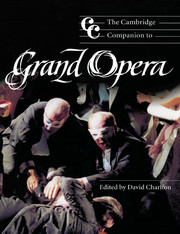Book contents
- Frontmatter
- 1 Introduction
- Part I The resourcing of grand opera
- Part II Revaluation and the twenty-first century
- Part III Grand operas for Paris
- 9 La Muette and her context
- 10 Scribe and Auber: constructing grand opera
- 11 Meyerbeer: Robert Ie Diable and Les Huguenots
- 12 Meyerbeer: Le Prophète and L'Africaine
- 13 The grand operas of Fromental Halévy
- 14 From Rossini to Verdi
- 15 After 1850 at the Paris Opéra: institution and repertory
- Part IV Transformations of grand opera
- Notes
- Select bibliography
- Index
10 - Scribe and Auber: constructing grand opera
from Part III - Grand operas for Paris
Published online by Cambridge University Press: 28 November 2011
- Frontmatter
- 1 Introduction
- Part I The resourcing of grand opera
- Part II Revaluation and the twenty-first century
- Part III Grand operas for Paris
- 9 La Muette and her context
- 10 Scribe and Auber: constructing grand opera
- 11 Meyerbeer: Robert Ie Diable and Les Huguenots
- 12 Meyerbeer: Le Prophète and L'Africaine
- 13 The grand operas of Fromental Halévy
- 14 From Rossini to Verdi
- 15 After 1850 at the Paris Opéra: institution and repertory
- Part IV Transformations of grand opera
- Notes
- Select bibliography
- Index
Summary
Scribe and the term ‘grand opera’
As we saw on p. 3, ‘grand opera’ is not a generic term with secure historical credentials. Since William Crosten's book French Grand Opera: An Art and a Business (1948) it has gained currency in musicology for a not very precisely definable subspecies of nineteenth-century opera that is French and influenced by France. From the late 1820s, long before the emergence of the generic paradigm, librettists and composers did, according to Anselm Gerhard, use the term to ‘characterise individual works’, but not very systematically. In 1803, for instance, when Henri Berton dedicated his Aline, reine de Golconde to Pierre-Alexandre Monsigny, he referred to the ageing Monsigny's 1766 setting of the same libretto as follows: ‘With your tuneful songs you enriched the poem La Reine de Golconde, grand opera’. In fact, the older work had been designated as a ballet héroïque and as an opéra. Critics of Auber's operas at their first performances did not use the generic label ‘grand opera’; nor did Scribe and Auber when their works were printed. It is, however, found in a number of Scribe's manuscript librettos for five-act operas such as Le Prophète and Noëma (intended for Meyerbeer and containing elements that were reused in L'Enfant prodigue), for four-act operas such as Dom Sébastien (set by Donizetti), for one-acters such as La Tapisserie or for the adaptation of Auber's opéra comique Le Cheval de bronze as a three-act opera-ballet for the Opéra.
- Type
- Chapter
- Information
- The Cambridge Companion to Grand Opera , pp. 168 - 188Publisher: Cambridge University PressPrint publication year: 2003
- 1
- Cited by



